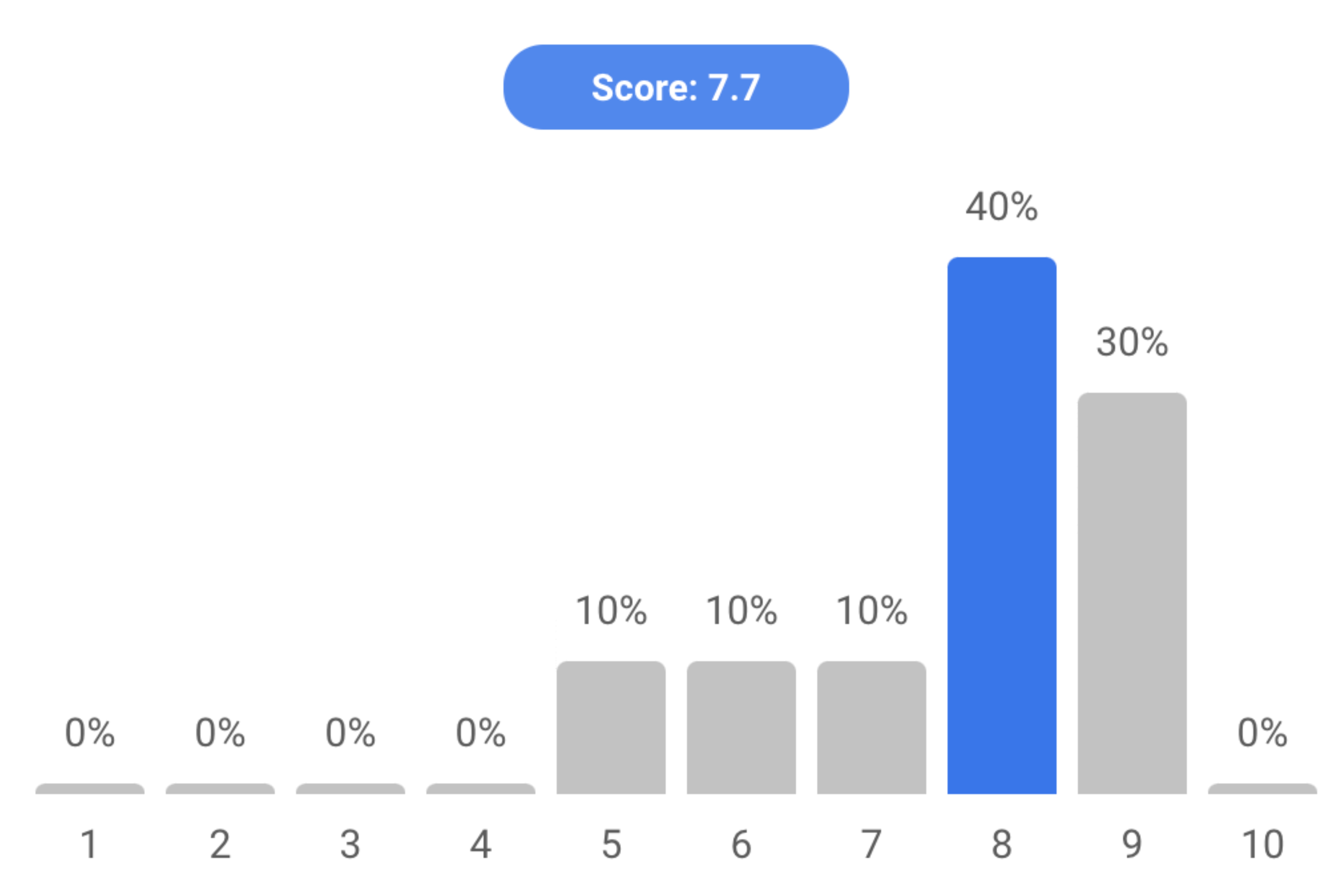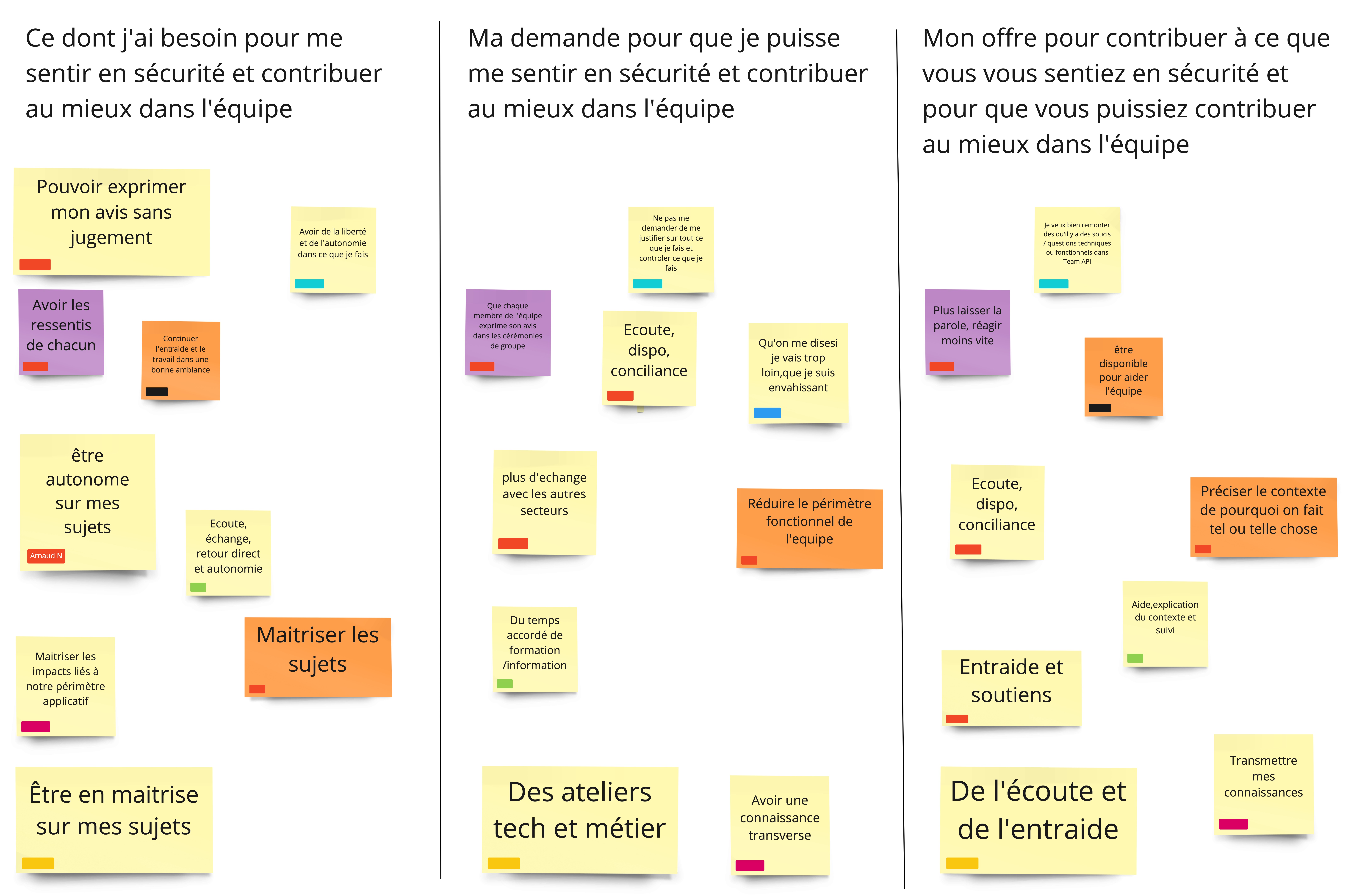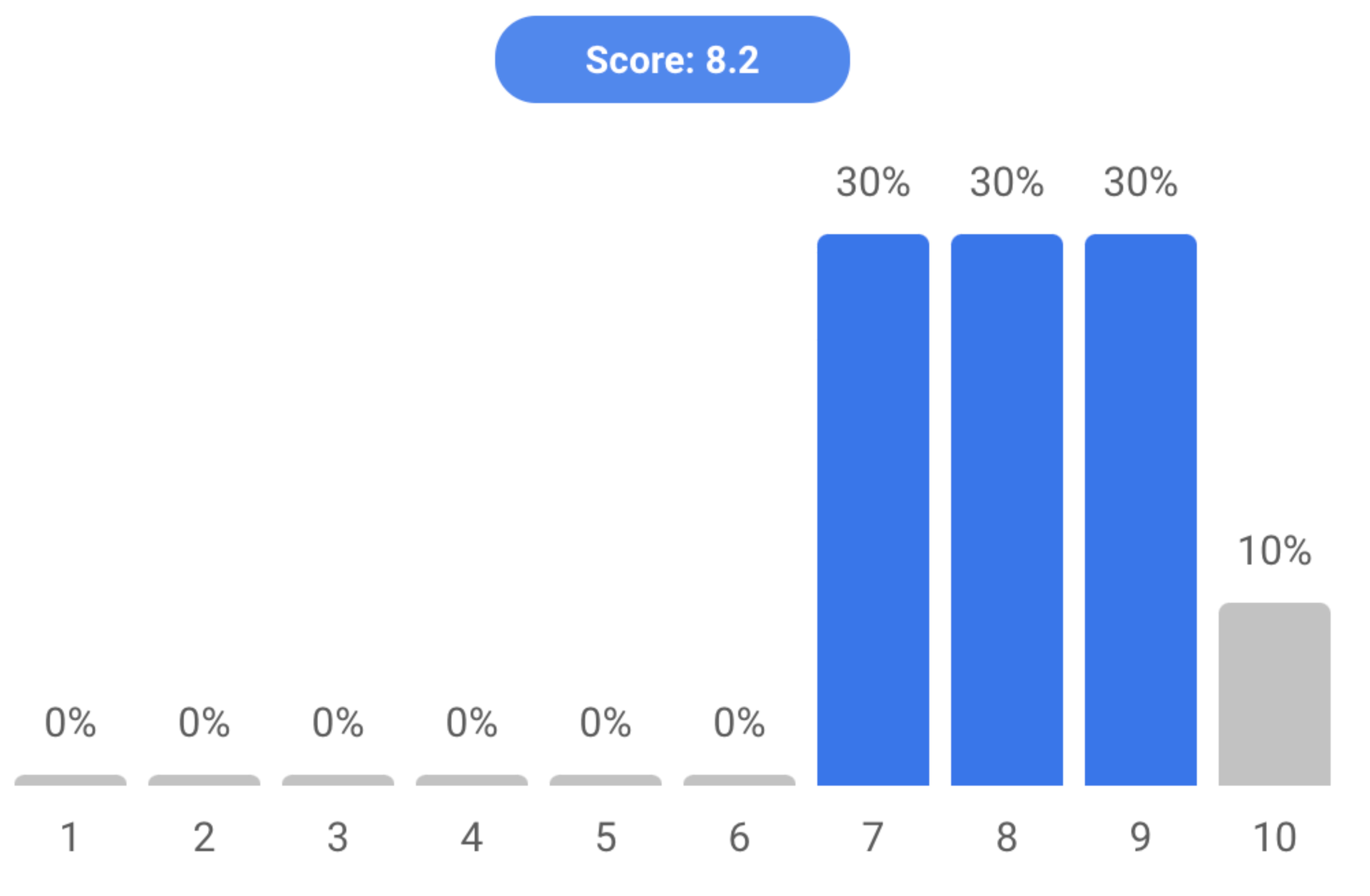
Pour permettre à une équipe de performer, un critère essentiel aujourd’hui bien connu est la sécurité psychologique. La problématique derrière cette notion est qu’elle n’est pas particulièrement intuitive. Le pire serait peut-être d’ailleurs de croire qu’elle s’instaure par l’injonction (un peu comme la Responsabilité).
Cependant, une premiere étape qui me semble pertinente est de commencer à en parler. Cela permet notamment de créer du sens ensemble et d’éveiller la curiosité à ce sujet.
C’est ce que j’ai proposé à une équipe et que je vous partage ici.
Contexte

Malgré l’intérêt assez « générique » du sujet, j’aimerais replacer un peu de contexte à cette proposition d’atelier.
En effet, l’équipe que j’accompagne est une équipe informatique composée de :
- 8 développeurs en prestation externe,
- 1 BA externe,
- 1 BA interne,
- et 1 PO interne.
Après quelques échanges, je découvre que la communication est très fluide entre les développeurs et les BA. La dimension externe / interne ne semble pas avoir d’influence ici. Cependant. la conversation avec le PO semble plus difficile car il peut avoir une aura parfois un peu écrasante.
Je distingue alors la partie externe / interne ici. L’hypothèse pourrait être qu’au sein de l’équipe se soit construite une relation client / fournisseur. En effet, les développeurs ou BA pourraient ne pas se sentir suffisamment en sécurité pour s’exprimer librement dans cette configuration.
Conception

Tout d’abord, partons des informations de base :
| Durée | Nombre de personnes | Format |
|---|---|---|
| 1h30 | 10 | Distanciel |
À partir de là, on peut commencer à construire 🙂
Partie 1 : Définitions
Pour aborder un sujet qui n’est pas toujours connu, je pense qu’il est toujours utile de définir ce que cela signifie. Dans un premier temps, ce sera donc une petite partie théorique qui permettra de faire travailler un petit peu la matière au groupe.
Partie 2 : Sondage
Dans un second temps, on va évaluer le niveau de sécurité psychologique de l’équipe à cet instant t, avec le niveau de compréhension qu’elle aura à ce moment. On pourra le faire simplement avec des outils comme Sli.do que j’ai découvert il y a quelques années.
En effet, l’intérêt de le faire sur un outil autre que le support Visuel habituel est de garder l’information anonyme. On cherche à analyser la donnée et la tendance plutôt que de pointer du doigt des personnes. L’exercice en lui-même est une représentation de la sécurité psychologique de l’équipe.
Partie 3 : Contrat d’alliance
Enfin, dans un troisième temps, il sera important d’actionner ces données. Je propose alors de demander aux personnes de définir leur contrat d’alliance qui se présentera sous 3 thématiques :
| 1 | Ce dont j’ai BESOIN pour me sentir en sécurité | L’idée est de pratiquer l’expression des besoins (et pour certains déjà, la recherche !). On touche ici également du doigt une certaine expression de sa vulnérabilité. |
| 2 | Ma DEMANDE pour me sentir en sécurité | L’idée est de pratiquer l’expression d’une demande, qui peut être satisfaite ou non, mais aura le mérite d’être explicite. |
| 3 | Mon OFFRE pour que vous vous sentiez en sécurité | L’idée est de pratiquer la générosité vers l’autre, ou encore l’empathie en conscience. En effet, cette 3 ème thématique a d’autant plus de sens qu’elle peut se bâtir à partir des 2 précédentes. Cela ressemble ici à la mécanique que j’utilise dans l’animation d’une Matrice Give and Take. |
Enfin, on pourra clôturer la session en invitant les participants à porter leur attention sur cette nouvelle caractéristique de leur équipe.
En résumé
| 1. Introduction (5′) 2. Définitions (30′) 3. Contrat d’alliance (45′) 4. Clôture (10′) |
Animation

Définition de la sécurité psychologique
Après la phase d’introduction, je partage une définition proposée par Amy C. Edmonson, auteur du livre « The Fearless Organization » :
“Perceptions des individus sur les conséquences des risques interpersonnels dans leur environnement de travail.
Cela consiste en des croyances considérées comme établies sur la manière dont les autres vont répondre lorsque quelqu’un va se mettre en risque : en posant une question, cherchant du feedback, rapportant une erreur, ou proposant une nouvelle idée. »
– Amy C. Edmonson (2014)
Nous échangeons rapidement dans le groupe afin de nous assurer que les éléments soient bien compris par tous.
Un questionnement émerge alors d’un des participants :
Mais c’est un peu comme la confiance non ? »
Un participant 🙂
Cela méritait alors une petite discussion à ce sujet ! 🙂
Différence avec la Confiance
Le Global Team Coaching Institute nous propose une grille de lecture nous permettant de bien différencier les 2 notions de sécurité psychologique et de confiance. La voici, ci-dessous :
| Sécurité Psychologique | Confiance |
|---|---|
| Construction de groupe | Construction individuelle |
| Mesure si cela est ok de partager des concepts et de faire des erreurs | Mesure si l’on peut compter sur l’autre pour faire ce qu’il a dit qu’il ferait |
| Mesuré par les membres d’équipe – ils « savent » si l’environnement est sécurisé | Mesuré par un individu à propos d’un autre |
| Vous donne, en tant que membre contributeur, le bénéfice du doute | Vous donnez à l’autre personne le bénéfice du doute pour faire ce qui doit être fait |
On peut voir ici que la sécurité psychologique est bien une notion de groupe, même si elle peut être étudiée individuellement. L’important est de comprendre que le contexte est bien celui d’un collectif quel qu’il soit.
Je trouvais intéressant cette notion où les membres d’équipes « savent » si l’environnement est sécurisé ou non. En effet, lors des échanges informels avec l’équipe, il était facile de connaître la réponse à cette question ! (Si tant est que l’on pense à la poser ;-P).
Nous échangeons donc un moment à ce sujet avant de nous atteler au coeur de notre atelier.
Sondage
Avant de lancer la construction du contrat d’alliance, je propose de sonder l’équipe sur le niveau de sécurité psychologique actuel de l’équipe. J’invite donc chaque participant à se positionner sur une échelle de 0 (insécurité) à 10 (sécurité).

Je récupère les résultats et l’affiche au groupe complet :
On voit ici que le score moyen (7.7) n’est finalement pas si mauvais, Cependant, c’est la distribution qui va nous intéresser ici. En effet, les résultats varient de 5 à 9 ce qui est tout de même une différence notable.
Pour ne pas mettre en difficulté les personnes qui auraient voté 5 et 6, je propose simplement une réflexion autour des résultats tels qu’ils sont :
- Les résultats sont-ils cohérents par rapport à votre vision ?
- Êtes-vous surpris du résultat ? De la distribution ?
- Quelle perspective cela vous donne-t-il ?
Il est toujours intéressant de voir qu’à partir de résultats de ce genre, on peut facilement créer des conversations. En effet, les chiffres en eux-mêmes ne signifient rien, c’est la création de sens collective qui a de la valeur.
Après quelques échanges, je propose de passer à la suite afin de confronter les participants au véritable travail de fond.
Alliance
Je présente alors les 3 thématiques au groupe puis leur laisse une quinzaine de minutes pour y répondre.
J’aurais également pu faire le choix de les faire une par une et de débriefer à chaque fois, Cependant, dans mon idée, les 3 thématiques faisaient partie d’un même processus de pensée : la première amenant à la deuxième qui amenait à la troisième. J’ai donc préféré laisser l’opportunité à chacun de réfléchir individuellement plus longuement.
Les résultats obtenus sont les suivants :

Comme vous pouvez le voir, les thématiques ont été légèrement précisées. En effet, j’ai pensé qu’ajouter l’intention de cette réflexion pourrait avoir une valeur significative sur l’orientation des retours.
Un petit peu comme les anciennes 3 questions du Scrum Guide :
| Trop souvent détournées en | Alors qu’initialement, c’était |
|---|---|
| Qu’est-ce que j’ai fait hier ? | Qu’est-ce que j’ai fait hier, pour l’équipe, afin d’atteindre l’objectif de sprint ? |
| Qu’est-ce que je vais faire aujourd’hui ? | Qu’est-ce que je vais faire aujourd’hui, pour l’équipe, afin d’atteindre l’objectif de sprint ? |
| Quels sont mes obstacles ? | Quels sont les obstacles, de l’équipe, qui l’empêcherait d’atteindre l’objectif de sprint ? |
On voit bien ici que l’ajout de l’intention change drastiquement la question à laquelle les personnes vont répondre ! 😉
Nous effectuons le débrief par thématique plutôt que par personne. C’est un choix comme un autre mais l’objectif était d’avoir une idée de la cohérence d’ensemble.
Les réponses sont diverses et variées. Cela est ok dans le sens où chacun a perçu les questions d’une certaine manière et donc a répondu selon ce spectre. Il était cependant surprenant, néanmoins intéressant, de voir que pour certaines personnes, la connaissance aidait au sentiment de sécurité.
Digression
Cela m’a d’ailleurs amené à digresser un moment en évoquant les travaux de Daniel Pink, dans son livre « Drive » ou « La vérité sur ce qui nous motive« . En effet, il explique que la Maîtrise, l’expertise que l’on peut avoir sur un sujet fait partie des 3 motivateurs intrinsèques en plus de l’Autonomie et de la Finalité.
Cela m’a alors fait réfléchir sur le lien entre ces 3 motivateurs, non pas comme des entités indépendantes mais au contraire comme des composantes en interaction :
Si je sais où je veux aller et pourquoi (Finalité OK),
que l’on me laisse l’espace nécessaire pour décider de comment je vais y aller (Autonomie OK),
mais que je n’ai pas les compétences pour faire ce que je souhaite faire (Maîtrise KO)
alors je peux me sentir en insécurité et avoir du mal à prendre des initiatives ou à m’engager dans mon travail.
– Réflexion O.My
Gardiens de l’alliance
Après avoir explicité l’ensemble des post-it et échangé autour des besoins, des attentes et des offres, j’ai proposé à 2 personnes de prendre le rôle de Gardiens de l’alliance.
Ces 2 gardiens auront le mandat d’intervenir lorsque le contrat d’alliance est en passe d’être enfreint. En effet, ils pourront rappeler ce qui a été défini ensemble et pourront ainsi aider à sécuriser l’environnement pour ses membres.
On cherche donc ici à actionner le contrat, à protéger l’équipe et à faire progresser le niveau de sécurité psychologique du collectif.
Il est intéressant de voir que les 2 personnes qui se sont portées volontaires sont les personnes ayant un haut niveau de sécurité psychologique ! 😉
Conclusion

La sécurité psychologique me semble être un inévitable dans le domaine de l’accompagnement d’équipe.
Même si comme moi, vos connaissances du sujet ne sont pas très approfondies, il peut tout de même être utile d’aborder le sujet avec les collectifs que vous accompagnez. En effet, cette thématique donne lieu à des conversations intéressantes et aide l’équipe à travailler sur son mode de fonctionnement.
Ne soyez donc pas surpris si cela débouche sur des actions permettant à chacun de développer son mieux être dans le collectif. et par suite, son engagement et sa motivation ! 😉
Et pour conclure, voici le sondage effectué quelques semaines plus tard :

Les chiffres sont bien évidemment à prendre avec parcimonie mais les échanges semblaient aller dans la bonne direction ! 😉







Une réponse
C’est vraiment bien d’aborder ce sujet, trop souvent mis de cote ou souvent sous estime. Bravo 🙂